#Native American Indian Style
Text


















Native American Indian Style
Edited by Kesaharu Imai
World Photo Press, Tokyo 2011, 208 pages, 21x28,5cm, ISBN 9784846529000
euro 50,00
email if you want to buy [email protected]
A diverse catalogue of Native American culture, including numerous artefacts from the Smithsonians National Museum of the American Indian, this book gives a detailed account through photographs, drawings and texts of the wide spectrum of peoples and customs present on the continent prior to and contemporaneous with European settlement and expansion. From historical perspectives and cultural appropriations to detailed fashion overviews and modern day photographs, the full range of Native American society and traditions is explored.
25/06/24
#Native American Indian Style#Indiani d'America#Smithsonian Museum American Indian#fashion books#fashionbooksmilano
0 notes
Text

"I DON'T THINK THAT PEOPLE GENERALLY REALIZE WHAT THE MOTION PICTURE INDUSTRY HAS DONE TO THE AMERICAN INDIAN..."
PIC INFO: Spotlight on the late, great Sacheen Littlefeather poses backstage at the 1973 Oscars with the speech Marlon Brando had prepared after deciding to reject his Best Actor Oscar at the 45th Academy Awards on March 27, 1973.
OVERVIEW: "Marlon Brando had actually won and accepted an Academy Award for “On the Waterfront” at the 1955 Oscars, but he wasn’t as eager to attend the 1973 ceremony, which was taking place amid the Wounded Knee Occupation in South Dakota. Instead, he sent an actress and activist named Sacheen Littlefeather in his place, along with a prepared speech in the event that he won for his performance in “The Godfather.”
Littlefeather took the stage when Brando’s name was called, but she refused to accept the Oscar statuette from presenter Roger Moore.
“I’m representing Marlon Brando this evening and he has asked me to tell you in a very long speech, which I cannot share with you presently because of time but I will be glad to share with the press afterwards, that he very regretfully cannot accept this very generous award,” Littlefeather said, in part. “And the reasons for this being are the treatment of American Indians today by the film industry — excuse me — and on television in movie reruns, and also with recent happenings at Wounded Knee,” she continued amid booing and applause from the audience.
Brando later told Dick Cavett he was “distressed” by the audience’s treatment of Littlefeather amid the speech but ultimately felt that it was “a marvelous opportunity” to bring the issue to light.
“I don’t think that people generally realize what the motion picture industry has done to the American Indian, and as a matter of fact, all ethnicities, all minorities, all non-whites,” he told Cavett."
-- NEWS NATION NOW, "Academy Awards: Only 3 winners have ever refused their Oscars," by Michael Bartiromo, c. July 2022
Source: www.newsnationnow.com/entertainment-news/academy-awards-only-3-winners-have-ever-refused-their-oscars.
#Sacheen Littlefeather#Academy Awards#Academy Awards 1973#Marlon Brando#45th Academy Awards#Super Seventies#1970s#Cinema#The Godfather 1972#American Indian#Native American#70s#The Oscars#Oscars 1973#The Godfather#Native Americans#American Indians#70s Cinema#American Style#Best Actor#Oscars#Photography#Best Actor 1973#Marlon Brando Best Actor#1973
29 notes
·
View notes
Text
Indigenous People's Day

DR. HENRIETTA MANN
Cheyenne
On this Indigenous People’s Day, we are featuring Matika Wilbur’s recent publication Project 562: Changing the Way We See Native America, published by Ten Speed Press in 2023. Wilbur (b. 1984) is a visual storyteller and member of the Swinomish and Tulalip peoples of coastal Washington. She holds a degree from the Brooks Institute of Photography alongside a teaching certificate that has shaped her style of educating through narrative portraits.
Project 562: Changing the Way We See Native America, a book born from a documentary project of the same name, resolves to share contemporary Native issues and culture. In 2012 Wilbur set out from Seattle to visit and photograph all 562 plus Native American sovereign territories in the United States.
Wilbur’s engagement with the communities she visited resulted in the creation of hundreds of dynamic portraits and documentation of conversations about “tribal sovereignty, self-determination, wellness, recovery from historical trauma, decolonization of the mind, and revitalization of culture.” She refers to her portraiture approach as “an indigenous photography method” that includes several hours and sometimes days of interaction with the participants, an exchange of energy and gifts, and asking sitters to choose their portrait location. The outcome is a stunning collection of Native narratives and portraits.

GREG BISKAKONE JOHNSON
Lac Du Flambeau Band of Lake Superior Chippewa Indians

HOLLY MITITQUQ NORDLUM
Iñupiaq
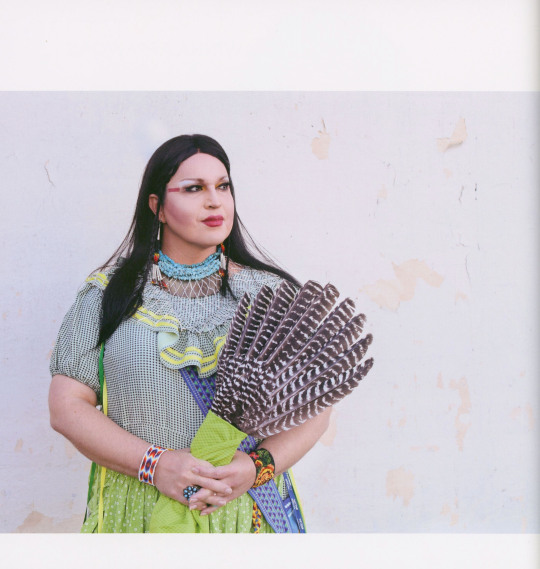
J. MIKO THOMAS
Chickasaw Nation

MOIRA REDCORN
Osage, Caddo

HELENA and PRESTON ARROW-WEED
Taos Pueblo/Kwaatsaan, Kamia
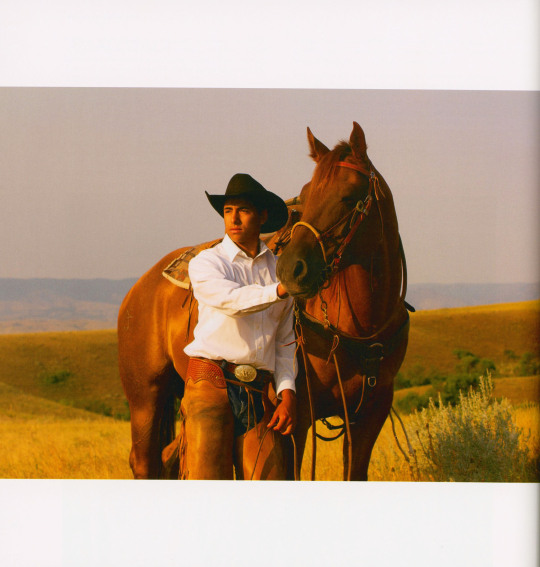
STEPHEN YELLOWTAIL
Apsáalooke (Crow Nation)

LEI'OHU and LA'AKEA CHUN
Kānaka Maoli
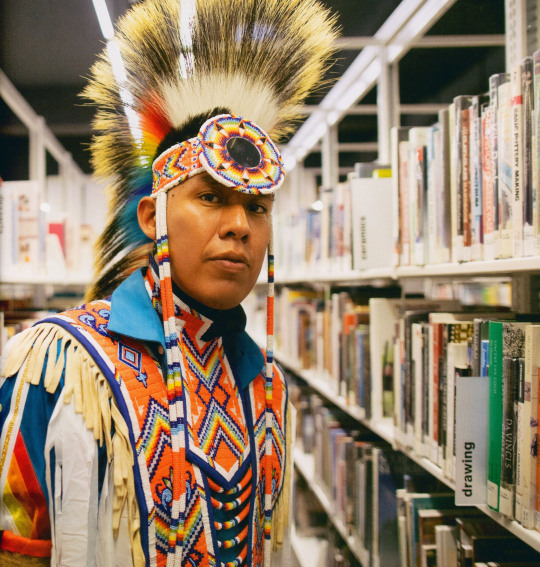
ORLANDO BEGAY
Diné
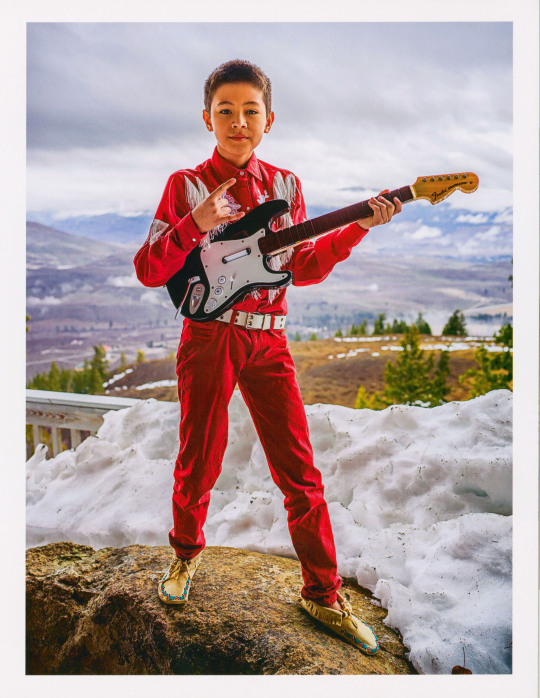
KALE NISSEN
Colville Tribes
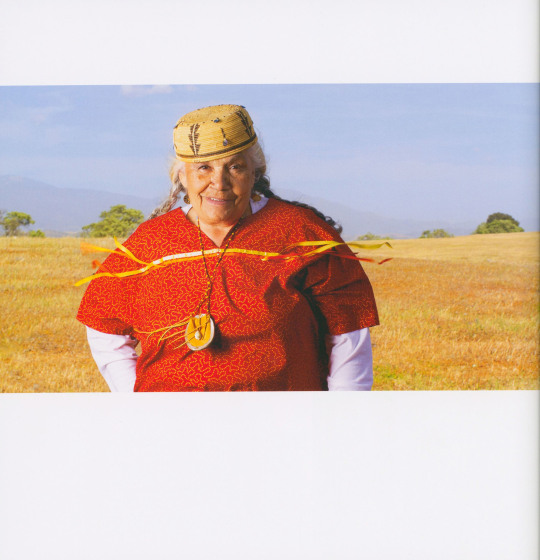
GRACE ROMERO PACHECO
Santa Ynez Band of Chumash Indians
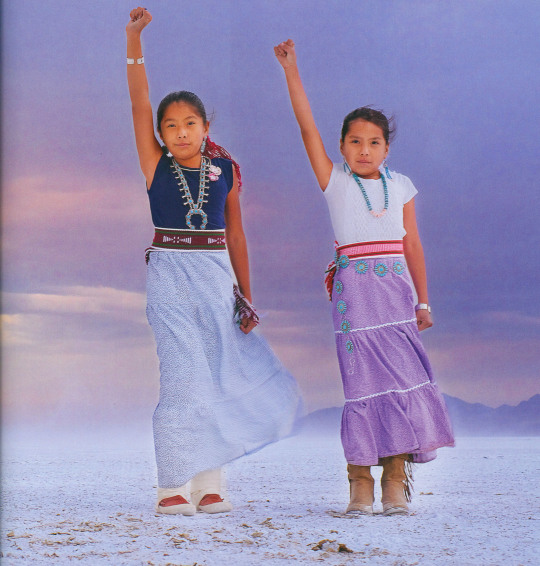
ISABELLA and ALYSSA KLAIN
Diné
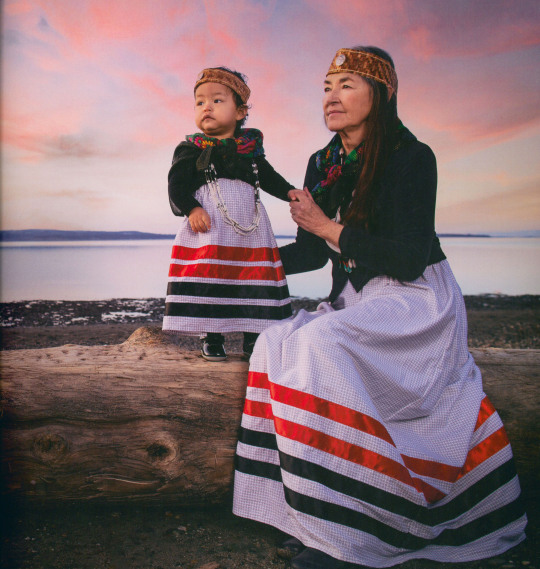
NANCY WILBUR
Swinomish
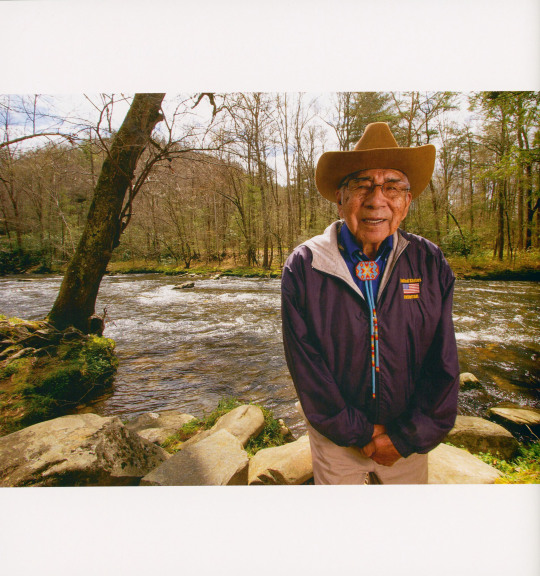
DR. JEREMIAH "JERRY" WOLFE
Eastern Band of Cherokee Indians
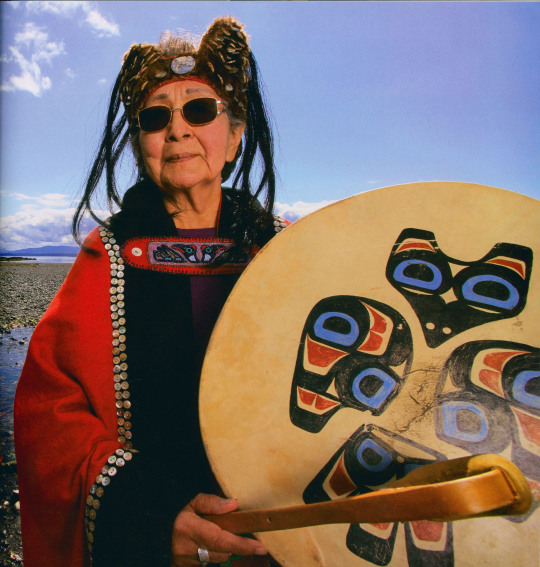
RUTH DEMMERT
Tlingit
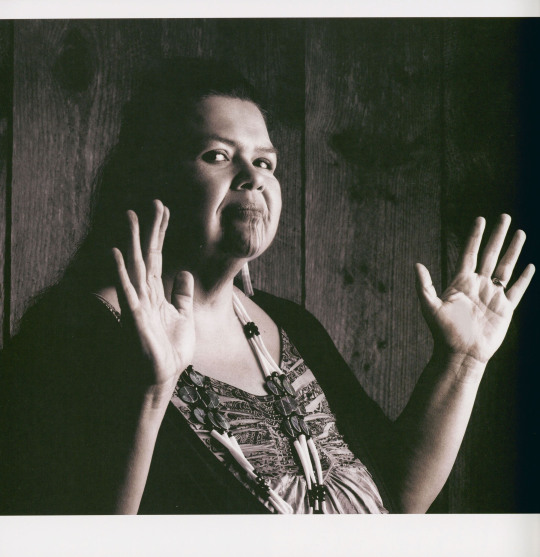
MARVA SII~XUUTESNA JONES
Tolowa Dee-Ni' Nation, Yurok, Karuk, Wintu
Matika Wilbur will be speaking on UW-Milwaukee's campus Thursday, November 16 from 6-7p.m. in conjunction with her exhibition Seeds of Culture: The Portraits and Voices of Native American Women on view at the Union Art Gallery November 16 through December 15, 2023.
-Jenna, Special Collections Graduate Intern
We acknowledge that in Milwaukee we live and work on traditional Potawatomi, Ho-Chunk, and Menominee homelands along the southwest shores of Michigami, part of North America’s largest system of freshwater lakes, where the Milwaukee, Menominee, and Kinnickinnic rivers meet and the people of Wisconsin’s sovereign Anishinaabe, Ho-Chunk, Menominee, Oneida, and Mohican nations remain present.
#indigenous people's day#matika wilbur#project 562#Ten Speed Press#Native Americans#holidays#UWM Native American Literature Collecton
831 notes
·
View notes
Text

Stikine division of Tlingit
Bear Screen
Northwest Coast: Tlingit
Native American, North American Indian, Tlingit
Circa 1840
This screen is perhaps the most important crest of the Shakes clan. The figure of a squatting bear with a doorway through her vagina is frontally presented, with arms crooked at the elbow so that her hands face palms forward just below her cheeks. The elbows nearly touch her bent knees. The ears (with tendants of hair on the outer edges), head, arms, hands, and legs are all red and without outlines, as are the organs of the body, which are depicted in X-ray style. The features of the face, the outline of the body, and the feet are all in black. Small, squatting figures of bears occupy each of the ears as filler designs. The face is carved slightly in bas-relief, the technique being highlighted by the black eyebrow, black-outlined eyes, black nose, and widespread mouth with black lips. The teeth, though carved, are unpainted. Small anthropomorphic faces fill in the pupils and nostrils. More conventionalized black faces with features in natural wood occupy negative space in the palms, elbows, and knees. Similar conventionalized faces are seen at the top, each side, and in the middle of the trunk of the bear-wife's body. These serve as a frame for her internal organs.
145 notes
·
View notes
Text
The Bakshi Family

Summary:
"The Bakshi Family" is an interactive fiction inspired by the sitcom Full House. After the untimely death of their mother, Rakesh Bakshi finds himself navigating the challenges of parenting his four children— The twins Alisha & Asim, Bevis, and the youngest, Darsh. The family's dynamics are further complicated by the arrival of their 25-year-old aunt/uncle, the MC, who must balance their own life while helping the Bakshi family cope with their loss. Amidst the chaos, the MC encounters five potential romantic interests: Bo Wu, Rakesh's best friend; Rakesh himself; Grace Clarke, a celebrity; S Smith, the neighbor; and Charlie Andrew, the teacher. As the MC forms bonds and supports the Bakshi family, they discover that love and laughter can heal even the deepest wounds in this heartwarming and entertaining interactive narrative.

Aunt/Uncle MC: Play as the 25-year-old aunt/uncle, juggling personal life and responsibilities to support the Bakshi family in the aftermath of their mother's death. (decide to play male or female and create a personality and a appearance)
Diverse Romantic Interests: Choose from five distinct romantic interests, each with their own personalities and backgrounds. Will you pursue a relationship with Rakesh, the best friend Bo, the celebrity Grace, the neighbor S, or the teacher Charlie?
Coping Mechanisms: Witness how each family member copes with grief in their own way. Delve into the emotional nuances of the characters as they navigate the healing process.
Parenting Challenges: Assist Rakesh, the father, in overcoming his chaotic and embarrassing parenting style. Navigate the ups and downs of family life while trying to understand the needs and emotions of each child.
Slice-of-Life Situations: Experience everyday situations reminiscent of the Full House sitcom, including heartwarming family moments, humorous mishaps in the kitchen, and the joys and challenges of raising children.

Bo Wu:
Personality: Bo is a 28-year-old Asian-American with a flare for the dramatic. He exudes arrogance, flirts unabashedly, and considers himself the coolest person in the room. Despite his rude exterior, there's a mysterious charm that draws people in.
Appearance: Bo has fair skin, dark brown eyes, and shoulder-length black hair tied in a small ponytail. Standing at 6'0ft, he embraces a relaxed and effortlessly cool style.
Rakesh Bakshi:
Personality: At 36, Rakesh is the Indian father of the Bakshi family. Despite his embarrassing and chaotic parenting, he is genuinely nice and friendly. He enjoys baseball, snowboarding (though it always ends badly), and casual cooking sessions that often result in culinary mishaps.
Appearance: Rakesh has tan skin, messy brown hair, a casual stumble, and stands tall at 6'4ft, giving him a laid-back and approachable look.
Grace Clarke:
Personality: Grace, a 23-year-old British celebrity, is sweet, insightful, outgoing, and enthusiastic. She enjoys singing, acting, dressing up, surfing, yoga, and cooking. Grace brings a positive and vibrant energy to every situation.
Appearance: Grace boasts porcelain skin, mid-length wavy auburn hair, and ocean-blue eyes. Standing at 5'3ft, she carries herself with a sensual and graceful demeanor.
Scott/Skye Smith:
Personality: S a 29 American Person, is the athletic neighbour with a shy, spontaneous, logical, caring, and strategic personality. They have a love for various sports and photography, bringing a unique dynamic to the neighborhood.
Appearance: Scott, at 5'8ft, features blond, bald hair, a beard, sharp features, rosy skin and an athletic, sporty look, while Skye, standing at 5'6ft, has blond hair in a loose bun, sharp features, rosy skin and also an athletic, sporty look.
Charlie Andrew:
Personality: Charlie, the 28-year-old Native American teacher, is efficient, reliable, playful, and intellectual. They enjoy reading, hiking, and drawing.
Appearance: Charlie has shoulder-length aqua blue hair, brown eyes, golden brown skin, and a professional look, standing at 5'8ft. They radiate a calm and intellectual aura.

demo: tba probably April
forum: tba probably April
other: soulmate-if , TBFamily-If
#interactive fiction#if wip#wip#no demo#romance#family#interactive novel#interactive game#TheBakshiFamily#The Bakshi Family#second if
210 notes
·
View notes
Note
Hi! You don't have to answer this if you don't want to, that's totally fine! But you talking about Orville Peck's appropriation of indigenous culture with his fashion choices made me realize that I had never considered that there might be some aspects of "cowboy clothes" that white ppl shouldn't wear and that was super wrong of me. Again, you totally don't have to answer this, but I was just wondering what ways a white person could wear "cowboy clothes" in a manner that wasn't disrespectful? Or perhaps, should we not wear them at all? I can't afford T yet, but when I can finally get it I was planning on getting a cowboy outfit to embrace my trans mascness, but if that would be wrong of me I can scrap that plan no problem!
Ehhh again this is actually SUPER HARD to answer because almost everything about cowboy fashion & the cowboy "aesthetics" are lifted directly from Native American fashion and culture, either because a lot of cowboys back in the day were Native American themselves (including Afro-Natives & Indigenous Mexican vaqueros) or they were White & just kinda. stole the look from the Native cowboys due to a number of factors.
If you google "cowboy jewelry" the first thing that comes up is silverwork & belts & turquoise jewelry, which is taken from Navajo metalwork. Fringed leather clothing? Again, many Native tribes did that (& in some tribes the fringes could mean something, its not just for looks), most popularily with vests, jackets, and pants. A lot if the leather jackets were a result of Native women just sewing their clothes the same but in a European styled cut. Compare this "cowboy" look below to a Lakota war shirt: both have hair embellishments dangling from the arms.


Studded belts? Inspired by Cheyenne mirror belts, which often also have metal studs in them & you'll still see Native pow wow dancers have this in their regalia. Floral vests? A lot of the inspiration comes from Plains floral beadwork. Geometric patterns and blankets? Came from Southwest or Mexican Native American blankets & designs, ask any Navajo weaver & they'll tell you the same. Feathers in cowboy hats? Who else is famous for wearing feathers on their heads--? Native Americans. The look is still popular with older Native men.
Hell, if you visit this site that sells Western/cowboy fashion, you'll see a SHITTON of appropriation going on, taking Native imagery & designs, including one taken from Native American ledger art, all on White models.

The appropriation of Native culture and fashion in the cowboy/western sphere is ongoing, and the influence that Native fashion & culture has in Western/cowboy fashion as it is is absolutely MASSIVE. I once said in another post that the cowboy/western aesthetic essentially belongs to Native Americans, Latines (especially Mexicans), and Black people. And the history of White cowboys has been one largely of colonialism, racism, and displacement of Indigenous peoples, and the masculinity associated with White cowboys especially is also steeped into racism & American patriotism (think John Wayne. There's a reason he's an American icon who played cowboys & killing Indians in films.). I think the only thing that isn't influenced from either appropriation or colonization is like, jeans. Even the style of cowboy boots themselves and potentially chaps were influenced from vaqueros.
So if you're White I'm not sure that'd exactly be a good route to take because trying to seperate Indigenous elements from this fashion/look (nevermind the problematic history of White cowboys) is almost impossible. Obviously I can't force you to do anything, but honestly if I were you, I'd try a different direction, because otherwise I think you'll find trying to do this will be very hard.
296 notes
·
View notes
Text
Monster Art History: The Wendigo
You may be wondering why the wendigo, which has become very popular in pop culture over the last 10 years or so, is usually depicted in Western sources with a deer head. This appears nowhere in Native American traditions, despite the creature having lots of folkloric variations. The association of the wendigo with deer is 100% Western, 100% modern, and has a long, weird history.
Just in case you need a primer, the windigo or witiko is a supernatural being from the Algonquin speaking nations of the eastern American continent. It appears as an emaciated figure, sometimes giant, sometimes covered in ice, sometimes both. In many stories, they have a literal heart of ice. Windigos are manifestations of cannibalism and winter, and hunt, kill and eat people. Someone who resorts to cannibalism to survive, or otherwise abandons their community for personal gain, will become one of them. A few stories tell of someone being “cured” and turned back into a human, but usually the only cure is to kill the monster. In the last several decades, native writers have associated windigos with capitalism and deforestation as an extension of their selfishness. If you would like to know more about the properly Native windigo in context, I recommend Dangerous Spirits: The Windigo in Myth and History by Shawn Smallman.
The creature first came into horror fiction with Algernon Blackwood’s “The Wendigo”. Note the spelling, which would become the standard in horror, and generally in non-academic Western sources. In that story, it is not associated with cannibalism, but instead is a more generic “evil spirit of nature”. This wendigo stalks white people in the wilderness and turns a Native character into a new wendigo by seizing them and flying with them into the sky. This definitely better fits fears about non white people, fears about nature, and how the one is closer to the other than “civilized” people. Its description in the story is vague (the most we get is that it has burned its feet away by running into the sky). But when the story appeared in Weird Tales in the 1930s, Virgil Finlay illustrated it like this, the first antlered wendigo I know of.

This story was ripped off by August Derleth, a prominent Weird author in the 1940s and the main popularizer of HP Lovecraft. In his Cthulhu Mythos stories, he introduces Ithaqua the Wind Walker, which is an alien version of Blackwood’s monster. This fits into Derleth’s vision of the gods and monsters of HP Lovecraft falling into the four classical elements, with Ithaqua being invented to represent Air. Ithaqua is usually depicted as an icy, emaciated giant, so ironically is one of the more accurate wendigos to Indigeonous beliefs in pop culture.
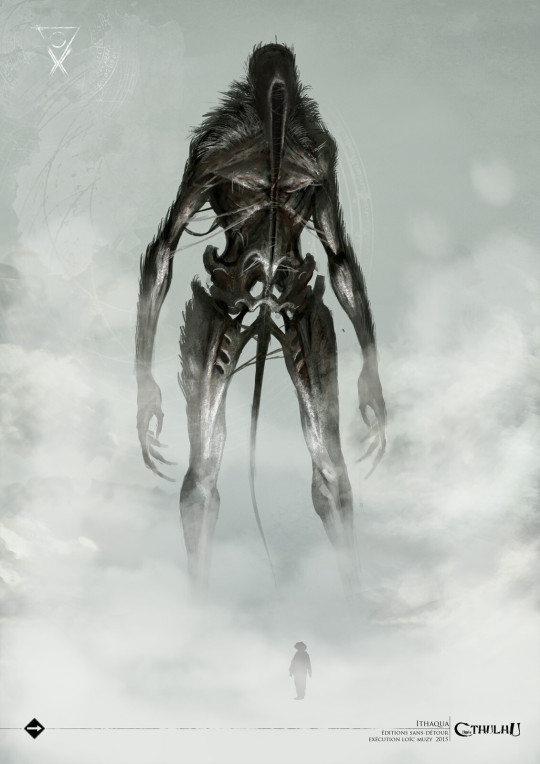
Image from a recent French edition of Call of Cthulhu RPG, by Loic Muzy
In Pet Sematary, Stephen King uses a wendigo as the reason for why the titular cemetery is cursed. This is an update of the classic racist trope of the “Indian Burial Ground”, except this time what gets buried there comes back animalistic and evil. The racist implications of that are pretty apparent. This wendigo is seen briefly and has ram’s horns. It does not appear in the first film adaptation, but does in the more recent one... with deer horns instead, because those are trendy right now.
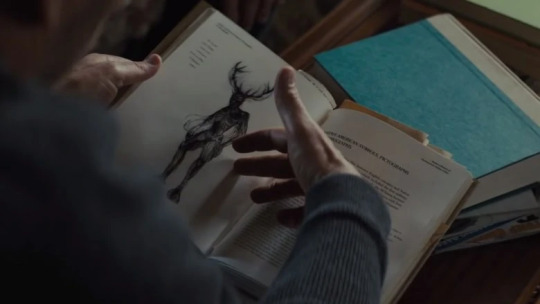
A good scholarly look at the real windigo versus the 20th century horror wendigo is “The Appropriation of the Windigo Spirit in Horror Literature” by Kallie Hunchman.
In the 1980s, a movie called Frostbiter: Wrath of the Wendigo was produced, but it wasn’t released until 1995 by Troma. From what I’ve read, it’s a pretty transparent ripoff of Evil Dead 2, with the characters being picked off in a haunted cabin with a zombie in the basement. The “twist” is that the origin of the horrors is a wendigo released by breaking a Christian demonology-style sacred circle. This wendigo is realized in stop motion animation, and has the most deer-like body yet.

A number of other independent horror movies in the 90s and 2000s used wendigos as a plot element. These follow the Blackwood/King approach of having the wendigo being something evil, ancient and Native American, reflecting white anxieties about living on stolen land more than Native anxieties about cannibalism and greed. Wendigo (2001) has the creature sicced on a white family when they hit a deer with their car. The Last Winter (2006) posits that global warming and fossil fuel extraction have unleashed the ghosts of dead animals, which are wendigo apparently, to revenge themselves on mankind. Which approaches the idea that greed is wendigo sickness, but I don’t think intentionally as a reference to modern Native literature. The “wendigo” in this movie are spectral moose and caribou.

The mainstream breakthrough of the deer-headed wendigo was in, appropriately enough for this blog, Pathfinder RPG. In “Spires of Xin-Shalast”, the last volume of Rise of the Runelords published in 2008, a wendigo is a major encounter. I suspect that either the author (Greg A. Vaughn), or one of the editorial staff had seen Frostbiter, as the setup involves a cabin haunted by dwarven cannibal ghosts who all killed and ate each other due to a wendigo’s influence. This wendigo is a hybrid of the Blackwood and Cree versions in terms of its MO: it is a cannibal ice spirit that wants to make more cannibals, and does so by abducting people and running off into the sky with them. Its design is the standard for what most Western artists depict wendigos as these days: an emaciated humanoid with the head and antlers of a deer (and the burned off feet of Algernon Blackwood, which are less common):
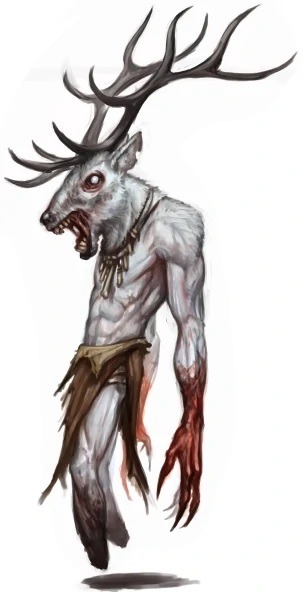
Image by Tyler Walpole, © Paizo Publishing
This wendigo definitely made a splash at the time; it was the first time I remember seeing a deer-headed wendigo, and art of that design started to become common. It pushed away previous wendigo depictions, which were typically werewolves (as French Canadian trappers had blended the concept with their own loup-garou, and Werewolf the Apocalypse had a whole faction of racist Native American “wendigos”) or shaggy and ape like (based more on the look of the Marvel Comics villain).
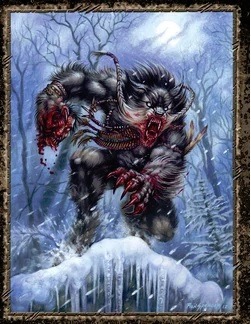
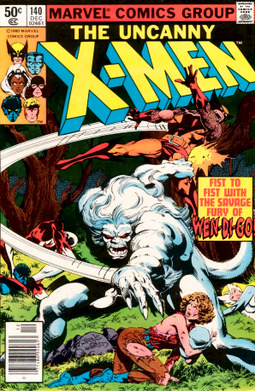
What turned wendigos from “folklore/horror monster” to “fandom blorbo” was Hannibal, which first aired in 2013. In that series, the first murder is a woman’s body impaled on a stag’s head, after which protagonist Will Graham has visions of a black stag, and a man with the antlers of a stag, representing murder, evil, and of course the cannibalistic murderer Hannibal Lecter.

Since Hannibal was super popular with the shipping fandom set, wendigo themed characters became popular in its wake, creating a wholly new way to culturally appropriate the wendigo. This was magnified by Over the Garden Wall, which came out in 2014, and its villain The Beast. The Beast is never called a wendigo, but is an antlered giant associated with winter, and so is commonly head-canoned as a wendigo and associated with them in fandom circles.

Which gets us to the modern day, where teenagers have misunderstood wendigo OCs, any character with antlers can be called a wendigo on the internet, and actual First Nations people with an actual cultural connection to the legend wish that people would just knock it off.
#and now you know#wendigo#windigo#witiko#creature design#art history#pathfinder rpg#algernon blackwood#august derleth#cthulhu mythos#stephen king#b movies#stop motion#hannibal#native american#first nations#cultural appropriation#long post
2K notes
·
View notes
Text
Hunger Games Capitol Fashion
So one thing about me is that I have so many Capitol headcanons, in particular about the evolution of their fashion. There was a question on the HG Reddit about what "middle Capitol" fashion was like. I think that the Capitol would have at one point emulated the style of the Districts. Call it, "District couture." There is a lot of evidence of the upper class throughout history imitating what they believed to be the fashion of the lower class. As an Indigenous person, I think of white hippies during the 1960s, who appropriated what they believed to be Native American fashion. White hippies were obsessed with what they thought was the "wild and free" " Indian" culture. I think the Capitolites would have done the same thing, taking a coal miner's outfit from District 12 and putting their nauseating Capitol spin on it. Romanticizing the "freedom" of life in the Districts. Another weird historical fact is that upper-class women used to do their makeup like victims of tuberculosis, thinking the disease made the sufferer look "angelic." Do not tell me you couldn't see Capitol citizens doing some shit like that.
#the hunger games#hunger games#thg#thg series#hunger games capitol#fashion#native american#indigenous#rich people are weird#history#district 12
29 notes
·
View notes
Text
Thinking about how the concept of cultural appropriation is sometimes misused by people to reinforce cultural conformity.
Cultural appropriation is real, involves elements of exploitation and lack of acknowledgment, but there really is a lot of disagreement about what constitutes cultural appropriation. A lot of people basically mis-define it as "x cultural group doing *something* that is normally associated with y cultural group."
Trouble is, this approach is often based on racial, ethnic, and cultural stereotypes, demands conformity, and fails to acknowledge the dynamic nature of culture. I've had people unironically say, "I want to convert to Buddhism but don't want to culturally appropriate." Using this understanding of cultural appropriation actually seriously harms the source cultures Buddhism is rooted in, who genuinely do want to have people of all races and cultures engage with Buddhism. Another example might be when people are told not to wear certain kinds of clothing or eat certain kinds of food. Unless the clothing or food has a particular symbolic significance, it's likely totally ok to use, so long as you're not doing it with the intention of mimicry or mockery. When people avoid engaging with these kinds of things for fear of cultural appropriation, it can harm the livelihoods of members of the source culture, who directly benefit from authentic engagement with their culture.
There are times when adopting cultural practices might actually be more appropriate than not doing so. A convert to a new religion probably should intimately engage with the source cultures that practice their new religion. A Muslim convert might pick up some Arabic, perhaps they should adopt some Middle-Eastern styles of dress if they believe that they should start wearing Hijab (though of course many Muslim converts might not choose to wear a Hijab). A Buddhist might adopt certain artistic practices associated with Asia, start cooking certain dishes due to dietary practices, learn a language to better communicate with their coreligionists, or decorate their home according to new conventions, as legitimate outgrowths of their new faith. Here, converts can act as culturally in-between because taking on the new culture of a religion can involve adopting practices from the cultures in which that religion is rooted. Refusing to engage for fear of cultural appropriation could actually be disrespectful, as is the case with some Western Buddhist movements who disregard traditional conventions associated with people from Asia.
There are also cases where converts become fully integrated into the source culture. Somebody who converts to Judaism becomes fully Jewish, for example.
These are just some of the reasons I think that when we present the concept of cultural appropriation, we should highlight the aspects of self-benefit, failure to acknowledge the source culture, exploiting people in the source culture, or the use of culturally reverent practices in inappropriate contexts. When we make accusations of cultural appropriation without understanding the whole situation, we are doing actual harm to both the individual we're accusing (who might be engaging in an appropriate and authentic way) and the source culture (who we might actually be isolating or demeaning). I think one really good indicator might be how they acquired a particular object or where they learned a particular skill or practice, though even that's not foolproof.
Are you learning to do yoga from somebody who knows enough about Indian culture to be qualified to teach it, or better yet, somebody who has been immersed in Indian culture? Did you buy that Native American jewelry from a Native American artist? Etc...
You genuinely need a lot of information to understand whether cultural appropriation is happening, and I see SO many people using the concept as a way of policing other people's lives, and doing so in a way that really does not promote a healthy crossculturally engaged society.
21 notes
·
View notes
Note
#though it IS fun to watch their faces when I say shit like 'when I was eight they told me if I was very very good now #I'd get to be white in the Celestial kingdom'

to put it mildly, HUH???????
Oh, man! So. It was once stated Doctrine (and is now just under-the-table doctrine) that the Mark of Cain was Black skin; that everyone of Black ethnicity was supposed to be enslaved, to work off the debt of Cain.
There's a whole bunch of scripture in the Book of Mormon about two purportedly Native American peoples, the Nephites and the Lamanites, who frequently were at odds. One civilization would gain righteousness and the other would lose it, typical adventure novel epic style bullshit--but the righteousness was marked, among other things, by the darkening or lightening of their skin. The darker skin, then, of the Native Americans in Joseph Smith's time, was used as justification for Mormons enslaving and massacring them.
This belief mutated, some, as Joseph Smith tuned the scriptures; eventually it was decided that there had been a war in heaven before any of us were born, and those of us who hewed to God's side from the start showed our righteousness on our skin and were born white. Everyone who had been less valiant could be marked by the various darknesses of theirs, and Black people were the very lowest of all, probably having sided with Satan for a while and then turned coat.
But righteous acts in life could make you paler, and while they'd never make you (the individual) white, they would lighten your family, so that hopefully in a few generations you'd be such a righteous family that only the most righteous souls were sent to be born in it, and all your grandchildren would be white.
This belief continued to be stated very baldly for a long time. In 1960, Church President Spencer W. Kimball said:
"I saw a striking contrast in the progress of the Indian people today … they are fast becoming a white and delightsome people…For years they have been growing delightsome, and they are now becoming white and delightsome, as they were promised…The children in the home placement program in Utah are often lighter than their brothers and sisters in the hogans on the reservation."
So, big yikes, right?
I was born into the Church in Anaheim, CA in 1982, daughter of a FilAm woman and a white man, both of them converts, both of them also born and raised in California. We stayed there for the first few years of my life, and then moved to Arizona, where I grew up in a town that despite its mere 8k population could support multiple LDS church wards. Our attendance at church was only fitful until I turned eight, when my parents really buckled down about us getting there every Sunday. Eight years old is the Age of Accountability; that is, the time when you can be expected to have learned good from bad, and have the agency to decide which way to walk. While there's a lot of poison you'll take in as a Mormon kid before that age, it really ramps up after you're baptized at eight.
So it was when I was eight that I heard for the first time (though far from the last) that my choosing to accept baptism put me on the right path, and that if I continued to Choose the Right for all my life--that is, I stayed chaste, earned all my blessings through righteousness, married a returned missionary in a Temple marriage and bore him a quiverful of children, raised them in the knowledge of God and the Church, and eventually died as a good matriarch--then when I made it to the Celestial Kingdom (the highest of the LDS' tiered heavens), I would find myself remade. No longer would I have the mark of my Preexistence sin; I'd be washed clean. Blue-eyed. Blonde-haired. And skin as white as cream.
19 notes
·
View notes
Text
Regarding this post going around:

Recommend checking out an article by Kasey Keeler and Ryan Hellenbrand, published at Edge Effects in 2021, which, aside from addressing the Ojibwe story about the Nanabozho fighting against logging, also describes the origin of Paul Bunyan as an icon of clear-cutting timber industry and, later, as a symbol of the advent of the US federal government’s “German-style” forestry management.
Some quick tidbits from their article:
- References to Bunyan appear in local print media from the 1890s onward, but Bunyan became more widely known in 1916 after a scholarly publication about the folklore. In the same year, 1916, an important mass media pictorial representation was made in a promotional pamphlet by the marketing team of a major logging company as a move to give them a folksly and “local” charm as the corporation expanded from Minnesota to California.
- That same logging company had owned the land that would become both Paul Bunyan State Forest and Chippewa National Forest.
- The first national forest created by act of Congress rather than presidential proclamation was actually Chippewa National Forest, which has been described as “a laboratory” to solve “the Indian problem” and discipline/contain Ojibwe people.
- Paul Bunyan was a sort of icon of German folklore in the region. Ironically, even though Bunyan was originally associated with clear-cutting, it would in fact be "German-style” forestry policy that (in Minnesota and later across the US) replaced the original clear-cutting industrial extraction methods with a "modern" and "sustainable" management approach meant for "sustained yield" (which still just treats forests as a resource to be extracted for profit).
---
Anyway, some images, captions, and text from the article [all text below is excerpted from the article]:
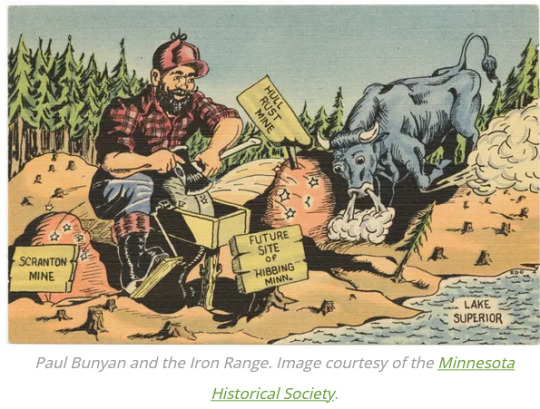
Across the Northwoods, a geography that spans the U.S.-Canada border, stories are used to make and claim space. [...] Throughout northern Minnesota, legends of Paul Bunyan, the fictional giant lumberjack, have been used to claim space. [...] Bunyan has been credited with creating Minnesota’s 10,000 lakes, the Mississippi River, and the Grand Canyon, while simultaneously logging millions of acres of forest. [...] Together, we juxtapose the history of two forests -- the Paul Bunyan State Forest and the Chippewa National Forest -- to reveal how German settlement, logging, and forestry have contributed to placemaking narratives, and how [...] nostalgia links past and present. Paul Bunyan’s literal and figurative imaginings advance American Indian erasure narratives, leading to the invisibility of these same communities today. [...] The Northwoods have been popularized and imagined as America’s version of northern Europe. [...] Across Minnesota, towns like New Ulm, New Munich, Heidelberg, and Luxemburg bear witness [...]. More recently, Native scholars Michael Dockry and Christopher Caldwell have examined [...] “the Menominee people’s profound sense of place and their intimate relationship with place.” [...]
---
Ojibwe dispossession, well underway by the late nineteenth century, is not told in any Paul Bunyan story. [...] The "heroic labor" of logging formed a significant portion of Great Lakes region economies [...] on the heels of, and entangled with, Ojibwe dispossession. [...] Formally established in 1908, the 1.6-million-acre Chippewa National Forest (CNF) lies nearly contiguous with the Leech Lake Reservation. [...] [T]he CNF was the first national forest created "for the benefit of [American] Indian people." [...] In 1902 came the Morris Act. Authored by [a] Duluth congressman [...], the act "created the first forest reserve established by congressional action rather than presidential proclamation." The act established the 225,000-acre Minnesota Forest Reserve as a “compromise,” a way to tackle the “Indian problem” while allowing for timber harvest. Here, Ojibwe homelands became “a laboratory for the first comprehensive forest management plans undertaken by a federal agency.” In 1928, the forest was renamed the Chippewa National Forest, as it remains today.
---
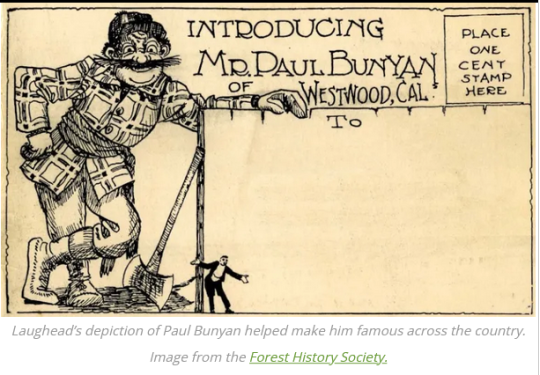
While the Chippewa National Forest forces us to consider the many ways logging and forestry has usurped American Indian peoples’ access to land, the nearby Paul Bunyan State Forest encapsulates the material legacy of symbolic myth. [...]
Officially recognized in 1935, the Paul Bunyan State Forest evolved from the site of the Red River Lumber Company sawmill. Founded in 1884, the Red River Lumber Company (RRLC) directly participated in and contributed to Ojibwe dispossession. By the end of the nineteenth century, he RRLC had purchased most of the land that comprises the present-day Pual Bunyan State Forest, milling millions of board feet of lumber at the company town of Akeley. [...]
The expansion of RRLC to California precipitated another key move: using Paul Bunyan in their marketing. William B. Laughead (pronounced Log-head), advertising manager in 1914 and a logger himself, spun another Paul Bunyan tale for the promotional booklet “Introducing Mr. Paul Bunyan of Westwood, Cal,” which included Bunyan’s first pictorial representation. This marketing campaign relied on the new and growing nostalgia for the grand logging days in the Great Lakes to keep the transcontinental corporation rooted in place.

With logging long established throughout the Great Lakes region, the ecological damage was clear. To remedy this, in the mid-1930s (German) forestry was introduced to manage timber on a sustained yield base. This, then, is the irony of the Paul Bunyan State Forest: named for an American legends who is said to have literally cleared the path for settlement, forest management now proposes to maintain the integrity of the forest. [...]
Though Paul Bunyan narratives dominate the landscape of the Northwoods, if we look closely we can see the ways Native people resist the legendary exploits. Indeed, a lesser-known Ojibwe oral story reminds us that the Anishinaabe people, their culture, and their histories will always prevail over dispossession and logging. In the story, Nanabozho, an Ojibwe trickster or cultural figure, confronts Paul Bunyan, who had already logged off most of the northeastern states before making his way to Minnesota. Nanabozho tells Paul to leave, to not log any more timber. A fight ensues, and [...] Nanabozho swings a Red Lake walleye at Paul, knocking him off his feet. As Paul stumbles, Nanabozho pulls at Paul’s whiskers, making him promise to leave the area. This is why, today, Paul Bunyan does not have a beard and why he is facing west at the statue on Lake Bemidji, as he prepares to leave the region.
This is also why we have the Chippewa National Forest, because Nanabozho and his Ojibwe kinsmen saved it from being logged. It is this contemporary narrative that highlights the complexity of Ojibwe storytelling [...].
---
Images, captions, and text as published by: Kasey Keeler and Ryan Hellenbrand. “Paul Bunyan and Settler Nostalgia in the Northwoods.” Edge Effects. 2 December 2021. [Bold emphasis and some paragraph breaks added by me.]
#abolition#ecology#indigenous#great lakes#imperial#colonial#ojibwe#victorian and edwardian popular culture#tidalectics#imperial forestry#multispecies#interspecies#geographic imaginaries
383 notes
·
View notes
Text
oc introduction: SilentDove Reyes



"It was my father who gifted me my name, y'know. He claims that, when I was born, I was silent. Him, my mother, my kokom, and the midwife thought I was a stillborn. They feared the worse. Guess I'm just naturally dramatic."
paloma (masterlist)

name: silentdove marie reyes.
age: 22 [july 13th, 2001].
pronouns: she/her.
gender: cisgender [female].
birthplace: near box elder, montana.
race: native american & hispanic.
nationality: american.
tribal affiliation: the chippewa-cree tribe of the rocky boy indian reservation.
occupation:
cryptological language analyst.
(milf-in-training) wife of simon riley.
languages: nēhiyawēwin, spanish, portuguese, russian, and french.
face claim: tanaya beatty

playlist.
electric pow wow drum — the halluci nation.
edge of seventeen — stevie nicks.
one woman army — porcelain black.
you driving me crazy (indian girl) — joey stylez, northern cree.
boss bitch — doja cat.
mother's daughter — miley cyrus.
celestial bodies — semiah.
mayores — becky g, bad bunny.




additional facts below the cut.
— dove is hispanic and lipan apache through her father. on her paternal grandfather's side, she traces her heritage to guerrero viejo, tamaulipas, mexico.
— through her mother, she has connections to the sweetgrass cree first nation located within treaty 6 territory.
— blessed with a learning tongue, she is a polyglot. her first languages consisted of a blend between nēhiyawēwin (the plains cree language), spanish, and english. during high school, she took on russian and french as a challenge, and later portuguese.
— on her right bicep is a traditional ojibwe floral design depicting bright orange tulips.
— she'll never kill a spider. in her mind, she recites the following: "if i am killed for simply living, let death be kinder than man."
— greatly enjoys the following:
contemporary jingle & old style fancy
ribbon skirts
ear piercings
beading
long distance runs
corridos
vines
scented creams & lip-glosses from bath and bodyworks.

notes: hopefully y'all find enjoyment in my dove :D with this now out of the way, i'll begin the main writing portion of the series <3
#silentdove r.#paloma series#call of duty#call of duty modern warfare#cod mw#cod mw2#cod mw3#call of duty oc#cod oc#simon riley#simon ghost riley#cod ghost#simon ghost riley x ofc#simon riley x oc#ghost x oc#orginal character#vic writes 🧸
46 notes
·
View notes
Note
If you were to look at the languages of Asia and Europe, you would see that many languages' word for tea is something like chai (Mandarin/Korean/Portuguese cha, Persian/Russian/Turkish chay, etc). It is repetitive to say "chai tea", even if chai does refer to a specific kind of tea. There is enough of a consistent difference between French tea and American or British tea to denote when tea is French, but nobody thinks thé tea is a legitimate phrase, and nobody would naturally think to use the phrase. There are people that see the French word thé's immediate linguistic proximity to the English word tea and recognize the redundancy there, but Francophones are also generally believed when they acknowledge a poor use of their language. Just because chai's linguistic proximity to the English word tea is less apparent to those who don't consider the presence of exchange between European and Asian languages doesn't mean chai tea isn't not repetitive and dismissive to Indians criticisms on Americans' use of the word chai
your bio says you’re southeast asian so I’m not going to tell you you can’t be critical of foreigners’ use of a word from your region. But also anything I could say to defend my (really harmless I think??) take on chai as a loan word is overshadowed by the fact that it’s now been two days of people reacting to that post and I’m tired. Many words enter other languages for various reasons and the way that other language folds them into itself is shaped by quirks of grammar, human communication, and that word’s purpose in its new language, not conscious disrespect. All languages have loan words in them that are used in ways that seem “strange” or “wrong” to native speakers of the language that word came from.
But I will say that I do not implicitly respect the French, and also if anyone asked me to make them “French style tea” I’d have no idea what they meant.
#catie talks#also isn’t the difference between english and american styles of tea just… that americans make iced tea and the british don’t?#we prepare hot black tea the exact same ways#you put a tea bag in a cup on boiling water and add milk and sugar#after of course microwaving the water in the cup to heat it up#THESE LAST COUPLE TAGS ARE A JOKE TEA GANG PLEASE DONT COME FOR ME
72 notes
·
View notes
Note
Happy Worldbuilding Wednesday! What would you say is the defining trait of any of your settings?
Omg, this is a very difficult question to answer because I do a LOT of worldbuilding, haha. But let's see...
I think, technically, the most defining traits of my settings is how different they are? I hop around the (in-universe) world in each individual story, and each in-universe country is inspired by real world cultures. But mostly drawing inspiration from ancient cultures because I explicitly prefer ancient history to modern. Plus, it's more fun to research. Which--ha--I'm definitely in the minority for feeling this way, I know!
I actually mentioned this recently toward the very end of another post I made recently, but I'll restate it for convenience's sake, haha... and then go into more detail.
Glavnran (tAR) is Slavic
(drawing primarily from early Slavic history, while I do my absolute best to figure out what the folklore was like before Christianity got its grubby hands on it. A polytheistic spinoff of Christianity exists in my story, appropriating a lot of its themes and imageries. That religion exists nowhere near Glavnran, so it has no place there. Also I think I've made it clear I dislike Christianity.)
Jhandar (tAR) is Indian
(off the top of my head, I can't recall if I was taking from any specific era, but I'm drawing on inspiration from Hinduism and there's a prominent caste system. Jhandar is also an empire, drawing inspiration from Rome and especially the rule of the Qin Dynasty of China. While not exactly thematically relevant, it's fun and helps explain some things I wanted happening in Glavnran/the surrounding countries. Oh, yeah, Glavnran is under the thumb of the Jhandan Empire. It's why there's so much tension between the Glavni and Jhandan peoples.)
(Also, the blue-and-red coloration here isn't a "good-and-evil" thing. To anyone who's read anything about my writing, it should be VERY clear that Glavnran isn't a great place and is, in fact, full of crime and -phobias of all sorts. It's based on their temperatures/climate, haha. I would've put Glavnran as orange but that fits other countries better.)
Lynsmouth (SaS) is Western European
(the Western World gets a lot of focus in media, so Lynsmouth and the country it takes place in that I've definitely named get to be the Token "West" in my writing. It gets inspiration from all over Western Europe, but I've primarily focused on France and the Netherlands for it. It's also got Italian-style mafias, haha. They have the Christian-adjacent religion where they glorify a single god. It is, however, subtly dying out, because of Lore and immigration of a sort. The "new arrivals" so to speak have their own religions.)
Kihroin (RFtA) is Northern African
(as in Islamic. I'm most likely leaning most strongly into Morrocan inspiration for anything "modern", but obviously most strongly leaning toward ancient history. Islam itself obviously won't appear in my writing, as I'm working within a fantasy world with provably real pantheons of gods. I haven't decided how I'll adapt their hyper-religiousness into Kihroin, especially because I'm personally uncomfortable with religion (though I bet you couldn't tell) and yet want to adapt something that major to their modern culture(s) into my writing. Yet another reason RFtA isn't a current project.)
Cirrane (RFtA) is Latin American
(given that actual Native American history is incredibly difficult to get our hands on--cough cough THANKS COLONIZERS, THANKS CHRISTIANITY cough cough--it has a lot more modern inspiration(s) than ancient. Howeverrrr... that's not necessarily a "bad" thing considering that Cirrane is a very bad place and I know plenty of people will @ me accusing me of racism for it anyway. Nah, man, it's pretty much everywhere in my writing! It's almost like it makes for a better story! Also my Mexican gf approves of what I'm doing with it, so take THAT, SJWs.)
(Oops, I ranted there for a second. Long story short, it takes a lot of inspiration from all over Latin America! That applies to the other two "Latino" countries too, though, haha. Besides that, it's also stolen quite a bit of imagery from Rome. Ah, that must be where the Evil's from. /hj)
Tzakah (RFtA/tCC) is also Latin American
(one of my favorite places in all of my worldbuilding!!! Is also extremely tropical. It's a lot more "original" of a culture due to worldbuilding stuff, but it still takes a lot of Latin American Inspiration.)
Minogua (RFtA/tCC/???) is the last Latin American country
(explicitly has a previous history of colonization that they've (relatively) recently shaken off through rebellion and ousting the authorities from other countries. Tackles a lot of those issues a lot more directly and has them more modern than the other two. Though it makes sense considering Tzakah was previously part of Cirrane. Regardless! There's lots to possibly tap into, but Minogua so far only has characters originating from there. Well, and minor plots relevant to those characters but y'know. I definitely want to eventually make a story placed there eventually to more directly explore its themes!)
Honorable mentions/speedrun:
Isagnea (tAR, though idk how much it'll show up, and ???) is Italian
(not very worked on, but it's the home country of some side characters... hence why it's not really worked on. It'll definitely see more attention if and when it becomes relevant. Most likely, it won't be until if/when I work on another story focused on those characters. Or, y'know, it appears in another story.)
Ilyich (tAR, tho it likely won't show up more than once) is Slavic
(country Glavnran was once a part of, before they split off (not peacefully) over religious differences. Methinks a Christian-esque religion might actually be rather hated by the Glavni people...)
Shilyma (tAR, mentioned but not visited) is a Slavic/Asian mix!
(so, yknow, likely would take inspo from Mongolia? Not too developed, but is like Tzakah in that its origins are unique.)
Anispe (tAR, end of series, and ???) is Greek
(spoilers! 😁 But Jhandar is actively at war with it, trying to get them under its thumb as well! I have Plots to eventually make a story centered on Anispe before it was Anispe, too!)
Shaoraigh (SaS) is Celtic
(an oldie but goodie! I did a good bit of worldbuilding here in the past even though it's never appeared in my writing. One of its gods are VERY important in the worldbuilding, however.)
Drønhals (SaS) is Celtic/Norse
(Freya's home country, was once part of Shaoraigh (in-universe) but they separated over religious differences!)
Tulidin (tCC) is Chinese
(I'm probably changing its name eventually, though. Also has minor worldbuilding and a character originating from there.)
Shoutout to misc unnamed countries that exist, but I've never gotten around to naming them for one reason or another! Like, for example, the Jhandan-Glavni colonies Rieka and Adilzhan are from and the Hawaiian-and-Japanese-inspired country hidden away from the rest of the world. (Wish I could make it Pure Hawaiian, but... you try doing research on Hawaii. Join me in my hatred for Christianity.)
Can you tell I've been writing/working on this world for ten years?
This post has gotten WAY longer than I was expecting (though really I should've figured, smh) so I'll make this last bit quick:
The technology contained within each country/story is very different, both due to wealth gaps and time period jumps! There's... a lot of worldbuilding. The Arcane Rifts takes place approximately 200 years before Sun and Shadow and Rising From the Ashes (which are connected to each other), so that on top of the exploitation from Jhandar means they're not going to have the greatest tech for example. Sorry this was so long! Hope you enjoyed reading!!!
Also, apparently I have more of Western Europe in my worldbuilding than I thought. Now I'm disappointed in myself.
Also-also, I misread this Ask. I thought it was asking for the defining traits in everything... whoops. I made this WAY harder on myself than I needed to.
Tagging those interested!: @the-golden-comet @the-letterbox-archives @honeybewrites @darkandstormydolls @mysticstarlightduck
@urnumber1star @aalinaaaaaa
#the feychild worldbuilding#rising from the ashes#the arcane rifts#sun and shadow novel#answered asks#autistic writer#oh yeah btw that's probably a huge part of why I'm so obsessed with this stuff. Basically everything relevant to worldbuilding is#one of my special interests. Sooooo...#my writing#world building#fantasy worldbuilding#fantasy world#high fantasy#urban fantasy#fantasy#magic#magic world#worldbuilding#diversity#inclusivity#inclusive writing#inclusion#diverse characters#diverse books#diversehistorical#writers on tumblr#writeblr#writing#writerscommunity#writers
17 notes
·
View notes
Note
May I have some lovely book recommendations on this day <3 😁😁 I'm trying to read more this next year
you sure can!!!!! i'll list my fave reads of the past few years:
convenience store woman by sayaka murata -one of my fave books of all timeeeeee. its basically about a woman who just doesnt fit in into 'normal' society and even tho she's happy ppl feel like she shouldnt be bc she's not progressing w everyone else. if you've been the weird girl ever this book will
ring shout - p djeli clark. a historical fiction novel where the kkk are like demons and theres this organization of black hunters. its action packed but what makes it so amazing is the emotional growth of the characters :') an all time fave
the vanishing half - brit bennett. another AMAZING historical fiction book. its abt family lines....and colorism and twins and what it means to be white passing and privilege and generational trauma. it honestly has toni morrison core vibes where there's a lot of pain but thru love all is healed!
there's no such thing as an easy job by kikuko tsumura. a bit of an eclectic read. this woman takes on different jobs and they each give her grief in a new way. very relatable esp if you hate your job 😭
the vegetarian by han kang. THEE GOAT. i will recc this book until the day i DIE. and even then. its technically a horror story abt the fallout after a woman has a dream/vision and decides to stop eating meat but its sooo much deeper than that. its such a great look at how, as a woman, everything abt you is subject to critique down to what you eat
parasite eve. thee classic scifi horror the video game was inspired by! think frankenstein but there's a love story underneath. but also you question if it was love at all bc what if the mitochrondria inside of us are just manipulating everything we do? i loved it! writing style is a bit clinical but idc
my sister the serial killer by oyinkan braithwaite...i read this one in a single day it was THAT GOOD. sister is a serial killer and the fucking implications and fucked up shit that comes from lookism and family expectations and misogyny tbh. love it~
annihilation by jeff vandermeer. the first in a series but you can just read the first one. its sooooooooooooooooooo good. its a scifi book about this mysterious barrier off the coast that's slowly expanding and inside nature is reclaiming its space and most everyone that enters the barrier never returns.....another quick read bc it will have you HOOKED
yellowface by r f kuang. i don't usually enjoy satire but r f kuang really TOOK IT THERE. this is the most infuriating book you'll ever read but in the best way. this white author w an inferiority complex objectifies her friend that she secretly hates and then steals her friend's book. only thing is the friend is proudly asian and her book is abt specific cultural history so the white girl does diet yellowface and is just a massive bitch
beloved by toni morrison. how do you sum up beloved? i cannot sum up beloved. if i had to sum up beloved i would say 'love is a haunting but not every haunting is love and the only thing that can clear a haunting is love'
in the dream house by carmen maria machado. god probably the best prose i've read all year. a really beautiful but bittersweet autobiographical novel about a bisexual woman's experience with a fucked up abusive relationship and how subtle abuse can be. heavy subject matter but handled soooo beautifully.
the only good indians by stephen graham jones. WHEW. this is a horror......and this book will take you for a fucking ride i'll tell you that. its abt a group of native american men who were childhood friends and due to one mistake they're all haunted by...something that wants to get revenge on them. this book had me going 'DID THAT JUST HAPPEN?' multiple times
32 notes
·
View notes
Text
listening to educated by tara westover and it’s a fascinating book that paints a very real picture of the state of many “homeschooling” families as well as fundamentalist families. my one complaint at the moment is that you can, uh. really really really tell that she is a white mormon, based on the way she makes reference to native americans and regurgitates secondhand family stories about them without any kind of real analysis of the factual weight behind these stories (all while saying ‘indians’ too). i know the general narrative style is meant to keep one “in the moment” with her child self who did not and could not critically examine those stories, but it’s still somewhat unpleasant. otherwise a good book so far
10 notes
·
View notes